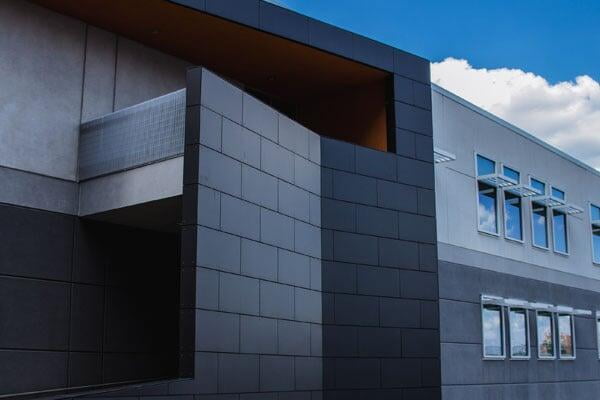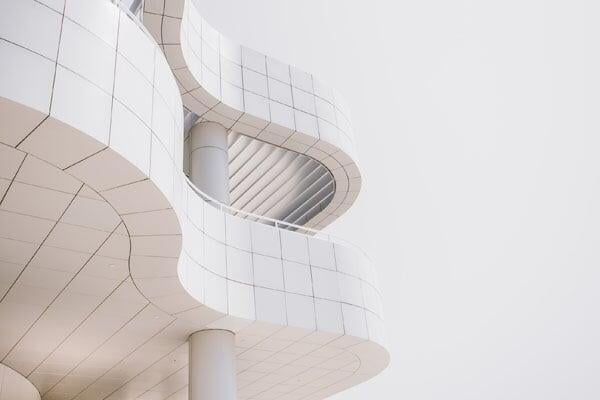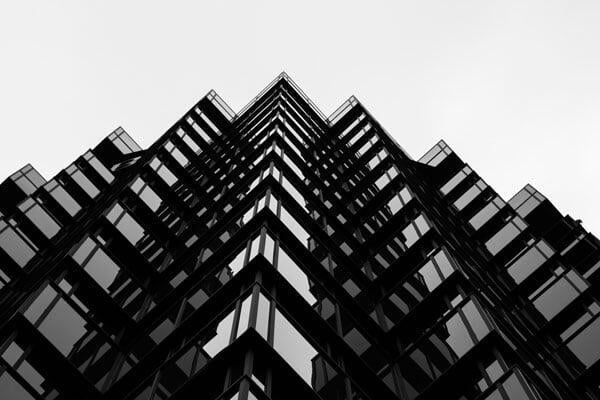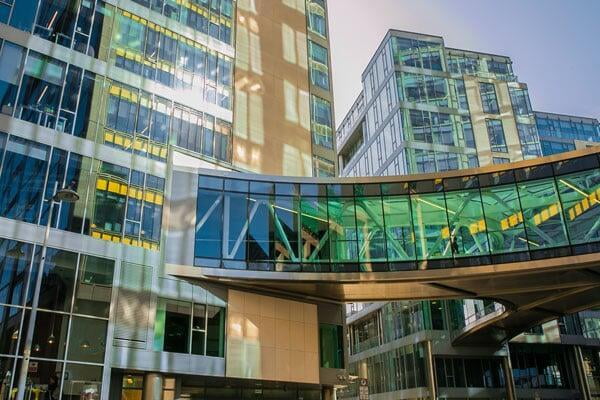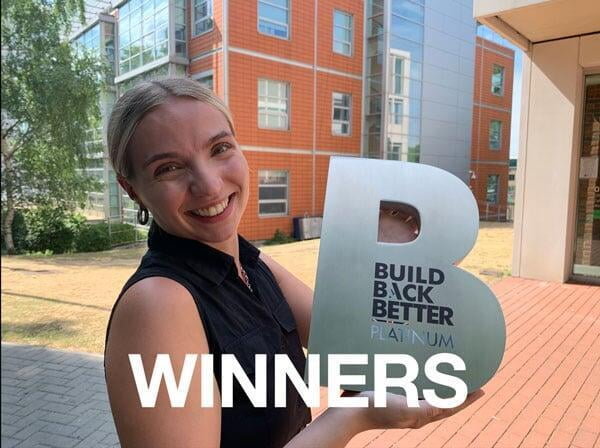
Winners announced in lighting category
A ‘bat superhighway’, a project which repurposes computer screens as lights for schools and a number of ‘dark sky’ projects were all named as winners in 2022 edition of the lighting category of the Build Back Better Awards. Lighting design practices taking honours included Speirs Major, Light Bureau, Licht Kunst Licht, Equation Lighting Design, Dark Source and PJC Light Studio.
A ‘bat superhighway’, a project which repurposes computer screens as lights for schools and a number of ‘dark sky’ projects were all named as winners in 2022 edition of the lighting category of the Build Back Better Awards. Lighting design practices taking honours included Speirs Major, Light Bureau, Licht Kunst Licht, Equation Lighting Design, Dark Source and PJC Light Studio.
In the product section, judges awarded honours to four innovations and two product concepts. These included a replaceable light engine for exterior fittings, a cellular controller and a multifunction desk tidy.
The winners for autumn 2022 are:
PROJECTS, INITIATIVES AND PRODUCT CONCEPTS
PROJECTS, INITIATIVES AND PRODUCT CONCEPTS

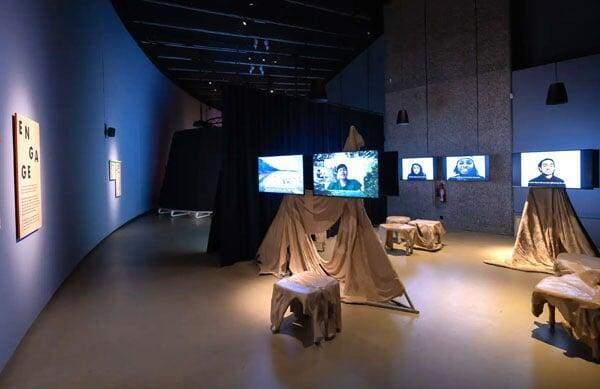
Our Time on Earth, Barbican Centre, LondonSpeirs Major
Our Time on Earth, Barbican Centre, London
Speirs Major
Lighting design practice Speirs Major challenged itself to create ‘its most sustainable project ever’ when it was tasked with illuminating the latest exhibition at the Barbican Centre in London.
Lighting design practice Speirs Major challenged itself to create ‘its most sustainable project ever’ when it was tasked with illuminating the latest exhibition at the Barbican Centre in London.
‘Our Time on Earth’ – which showcases creative solutions for climate change – is a temporary exhibition designed to travel for five years after finishing in the Barbican in August.
Speirs Major’s team, led by senior lighting designer Benz Roos, devised four key principles for the project: Use as much existing equipment as possible; design with a minimal number of luminaires; specify light fittings suitable for the circular economy; and ensure the visitor experience is excellent.
‘Circular economic and minimal embodied carbon were crucial principles from the start,’ says Roos. ‘The relatively new Cibse guidelines TM65 and TM66 helped us direct the specification towards circularity and low embodied carbon.’
The team assessed the market and found that the ZTA spotlight from Stoane Lighting was the ‘natural choice’. It has an ‘excellent’ TM66 rating of 2.6 and was the winner of both Build Back Better platinum and green awards in 2011.
Dr Irene Mazzei of Napier University was brought in to assess the overall design data and concluded that the new lighting would have embedded carbon of 2,263 kg.
The drivers alone are responsible for 472 kg of this, or 20 per cent.
‘To put this context,’ says Roos, ’38 seedlings would need to grow into trees for at least 10 years to offset these emissions.’
Roos says Mazzei’s assessment was an ‘eye-opener’ for the team. ‘Until now our studio has always put the experience and the visual effect of the light as the primary focus as concept stage, with the choice of equipment not considered until later in the process,’ says Roos. ‘This relatively small project has allowed us to begin to adjust our approach.’
Pic: Mark Allan Photography/Tim P. Whitby
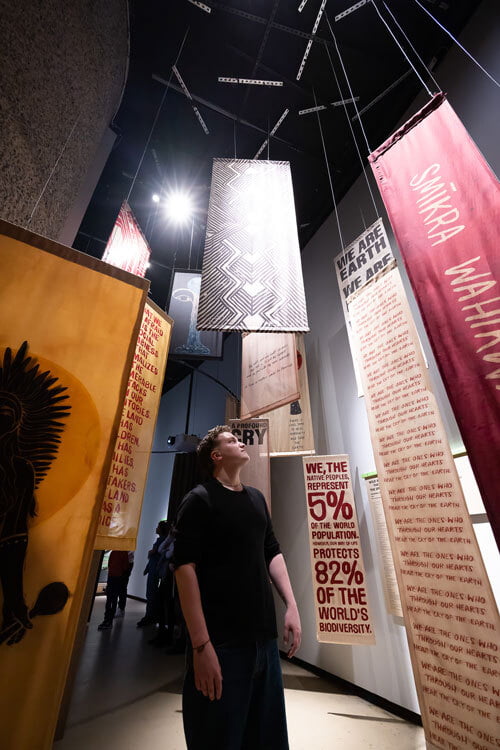

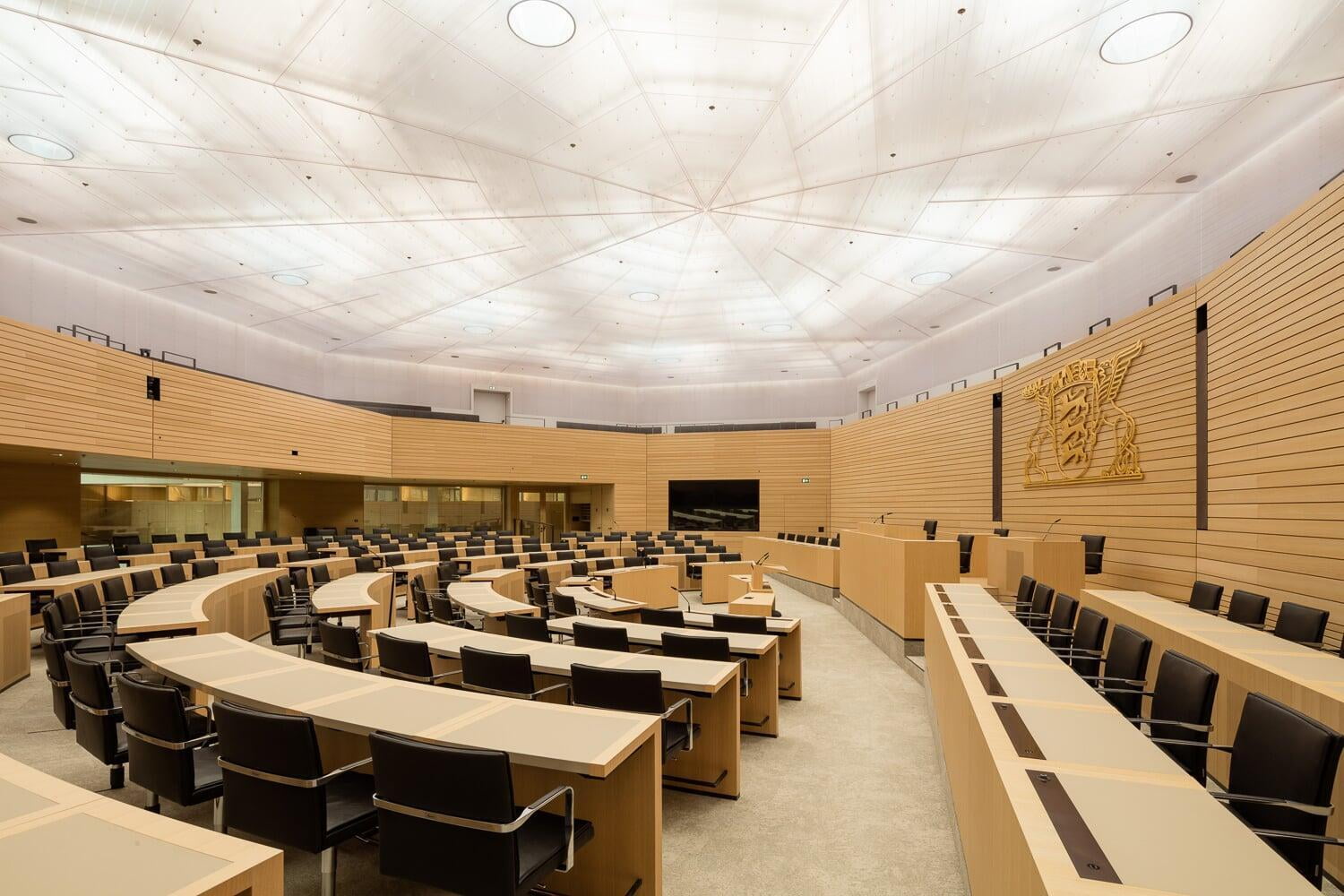
State Parliament of Baden-Wuerttemberg, Stuttgart, GermanyLicht Kunst Licht
State Parliament of Baden-Wuerttemberg, Stuttgart, Germany
Licht Kunst Licht
Lighting design practice Licht Kunst Licht and Staab Architekten collaborated on a sophisticated scheme which brings both diffuse and direct natural light into the debating chamber.
The renovation saw 12 large circular skylights with a diameter of 2.60 m and 36 smaller ones with a diameter of 0.80 m inserted flush with the flat roof. The smaller ones have reflective light bring light into the space via a translucent and satinised ceiling made of plastic panels.
The larger openings have conical light tubes which emit both diffuse light from its translucent surface as well as bring direct light to the space.
The daylight is supplemented by LED light sources.
Each seat is guaranteed a direct and nearly unobstructed visual connection to the sky. The lighting design team comprised Benjamin Dorff, Maik Czarniak, Tanja Baum and Edwin Smida.
Picture: Marcus Ebener
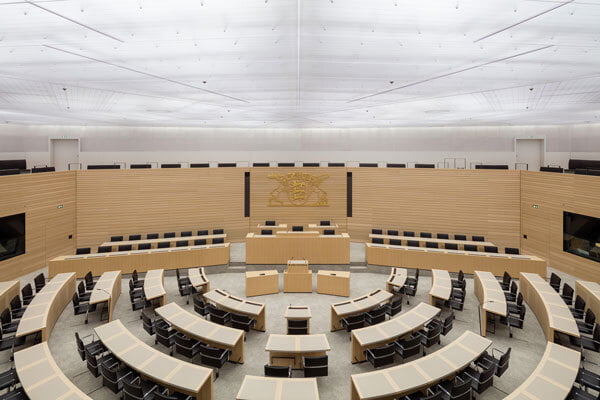
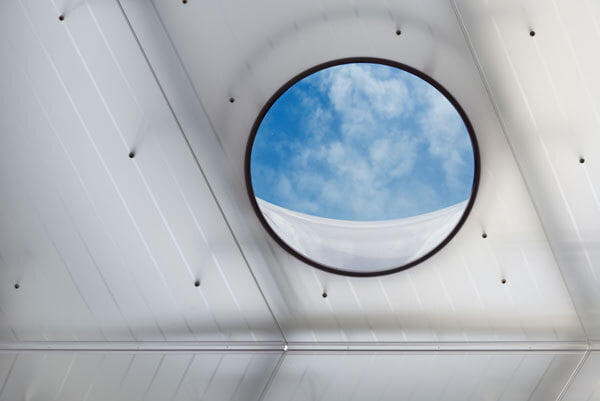
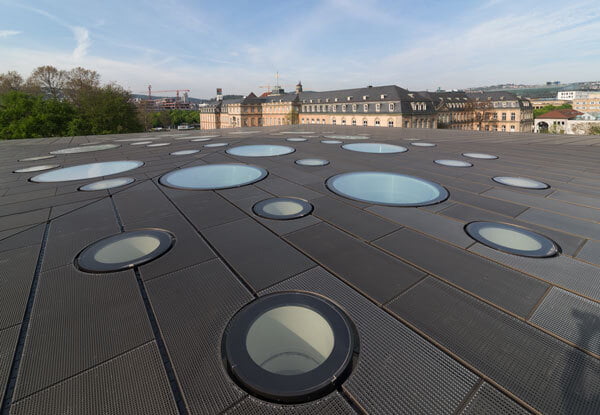
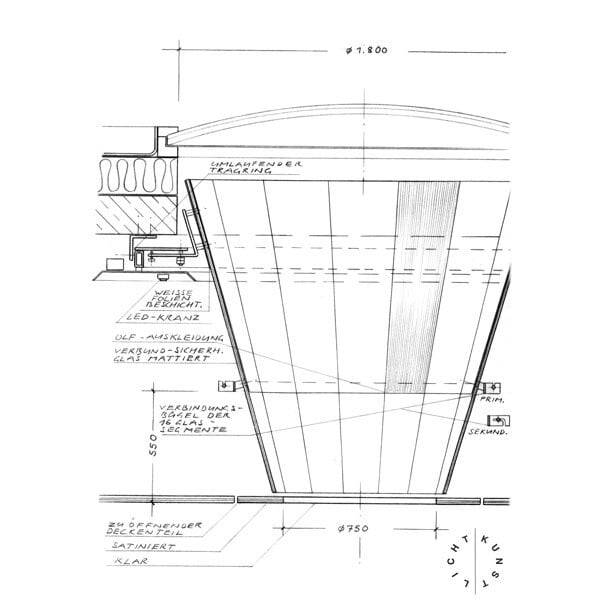
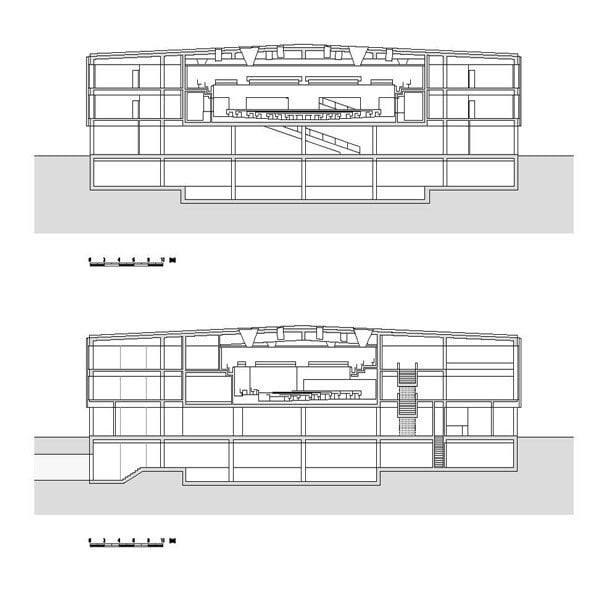

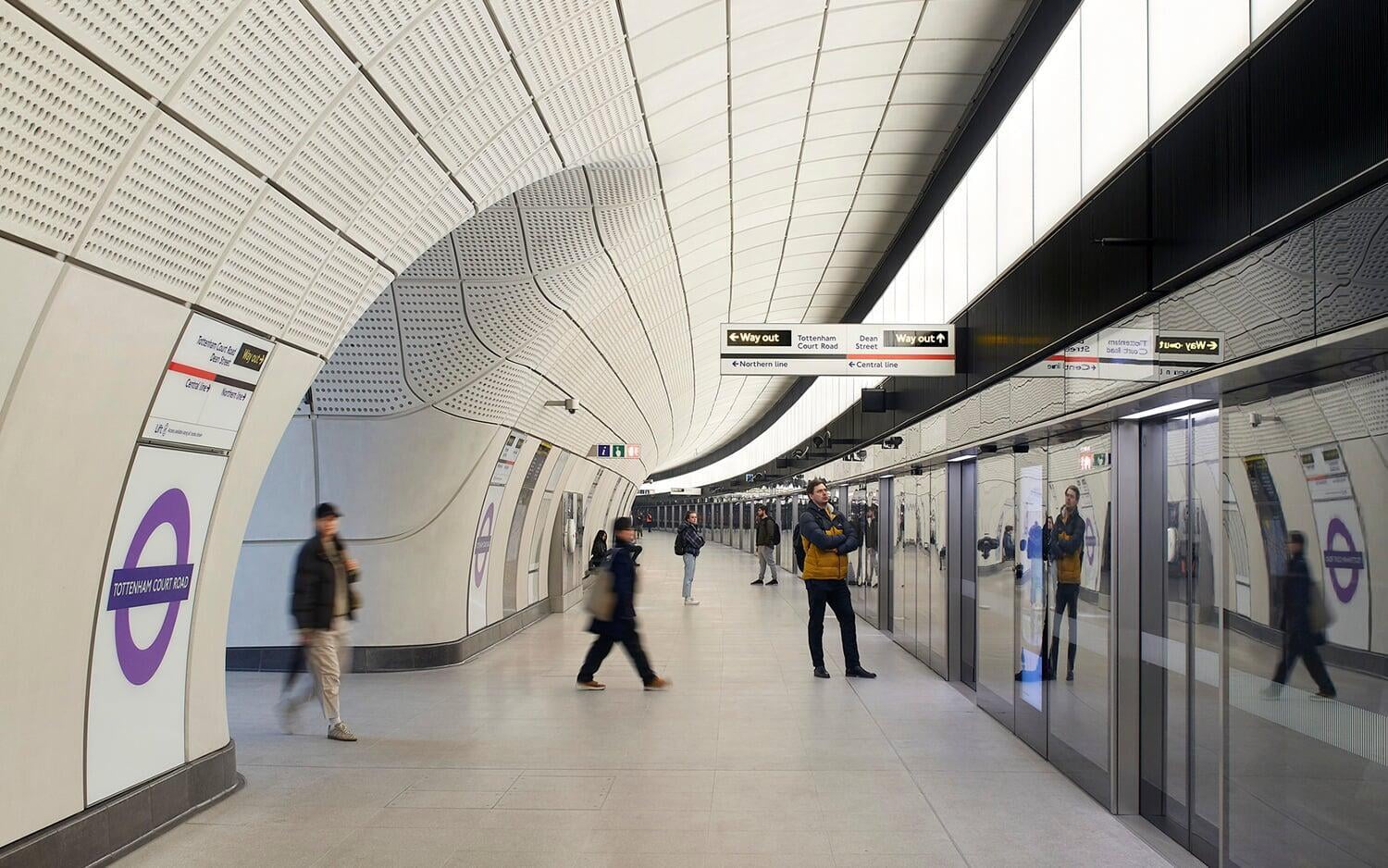
Line Wide Design, Elizabeth Line, LondonEquation Lighting Design
Line Wide Design, Elizabeth Line, London
Equation Lighting Design
The illumination of London’s newly-opened Elizabeth Line was designed by Equation Lighting Design. The bold design vision was to create a modern, minimal, elegant, and functional transport system that enhances the passenger experience.
The team took the brave decision in 2009 to commit to an LED-based scheme, despite London Underground’s desire to stick with fluorescent.
Indirect lighting is used in the concourses, escalator tunnels, and platforms to emphasise the spatial envelope rather than drawing attention to the luminaires.
There is a clear distinction between the use of ambient and accent lighting.
Intuitive wayfinding is promoted by using a cool white colour temperature (5000K) for the areas classified as ‘transition spaces’ whilst warm white (3000K) is applied in ‘wayfinding spaces’.
The various luminaire components are carefully integrated into the architectural design. A family of custom-designed products with a similar aesthetic and visual appearance.
The use of indirect lighting and the use of luminaires with diffuse luminous surfaces create a visually comfortable environment with fewer shadows and veiling reflections.
Good vertical illuminance has been prioritised in the lighting design in order to improve facial recognition of fellow passengers and enhance the legibility of the space.
The extended design life of the lighting installation meant that maintainability, continuous refurbishment of luminaire housings and component recovery principles were embedded in the design of luminaires and systems.
Additionally, designing for equal access for persons with disability and persons with reduced mobility was one of the cornerstones of the design.
Key suppliers were Future Designs, Designplan and Designed Architectural Lighting.
Picture: Morley von Sternberg

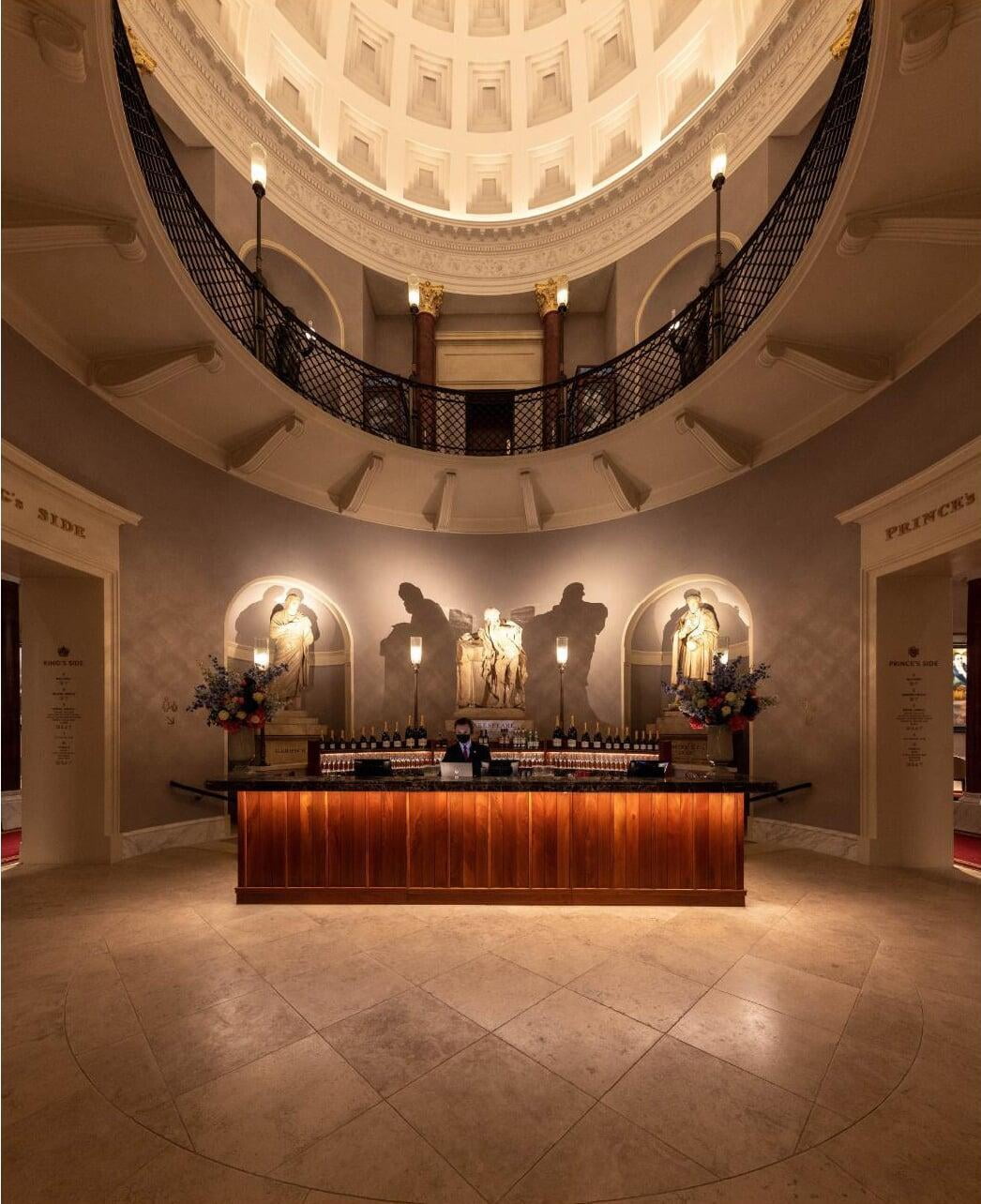
Theatre Royal Drury Lane, LondonBDP
Theatre Royal Drury Lane, London
BDP
For the first time in a century the Grade I listed Theatre Royal Drury Lane has been completely refurbished to cutting edge production standard, from the back of the house through the auditorium to the original 18th century Wyatt reception rooms.
The central vision was to reveal and restore Wyatt’s foyers and staircase - arguably the most impressive Georgian sequence of public interior spaces in existence.
BDP’s lighting team worked closely with Haworth Tompkins Architects to determine how each paint finish looks in daylight and under the warm candlelight that transforms each space in the evenings. Bright ceilings and vertical illumination celebrate the full drama of the restored Wyatt spaces.
With controlled low glare optics the team used the hidden fittings to deliver light levels and uniformity required for a public space, with particular focus on any changes of level or routes where congestion could become an issue. In a moment of inspiration BDP used the hand held lamps from the Muse Statue to deliver the emergency lighting!
In order to keep the light levels as low as possible throughout the day and evening BDP designed the optics and finishes of the corridors and spaces to ensure that that the eye can comfortably adjust from daylight into the 50Lx interior of the auditorium. Each change of level or collection of vertical details are illuminated locally to create a space that appears ‘warm’ rather than ‘dark’.
In the auditorium each Edwardian fitting and local ceiling moulding was re-distributed and increased in density to provide a uniform modern standard. Existing fittings were tested and inputted into calculation models to demonstrate in advance the improvements to lighting. Where the visual duplication fell below the requirement to read a programme, a series of discrete hidden ceiling details were included to ensure that every seat enjoyed a good light level at the correct angle.
The lighting is integrated within the original historic forms and uses a consistent layer of hidden spotlights and local accents to ensure all ages and visual impairments are catered for at every stage of the theatre experience: from first stepping into reception (high contrast reduction), legible orientation to aid wayfinding, subtle reduction of light levels to allow eyes to comfortably adjust, high contrast accents to primary stairs to prevent crowding, accents to bar and menu locations, seating and steps legibility and programme reading from auditorium chair.
Each of these functions was sought from a historic luminaire, and if not local then a secondary integrated and hidden accent was employed.
Each space was researched through archive records to determine the original intent of the lighting. From the outset of the design process, drawings and publications from the theatre’s history were studied to determine the focus of the lighting in each space, whether low level standard, wall sconce or chandelier.
Lighting designers on the project were Colin Ball and Jonathan Redden.
Pics: Philip Vile & Tom Niven

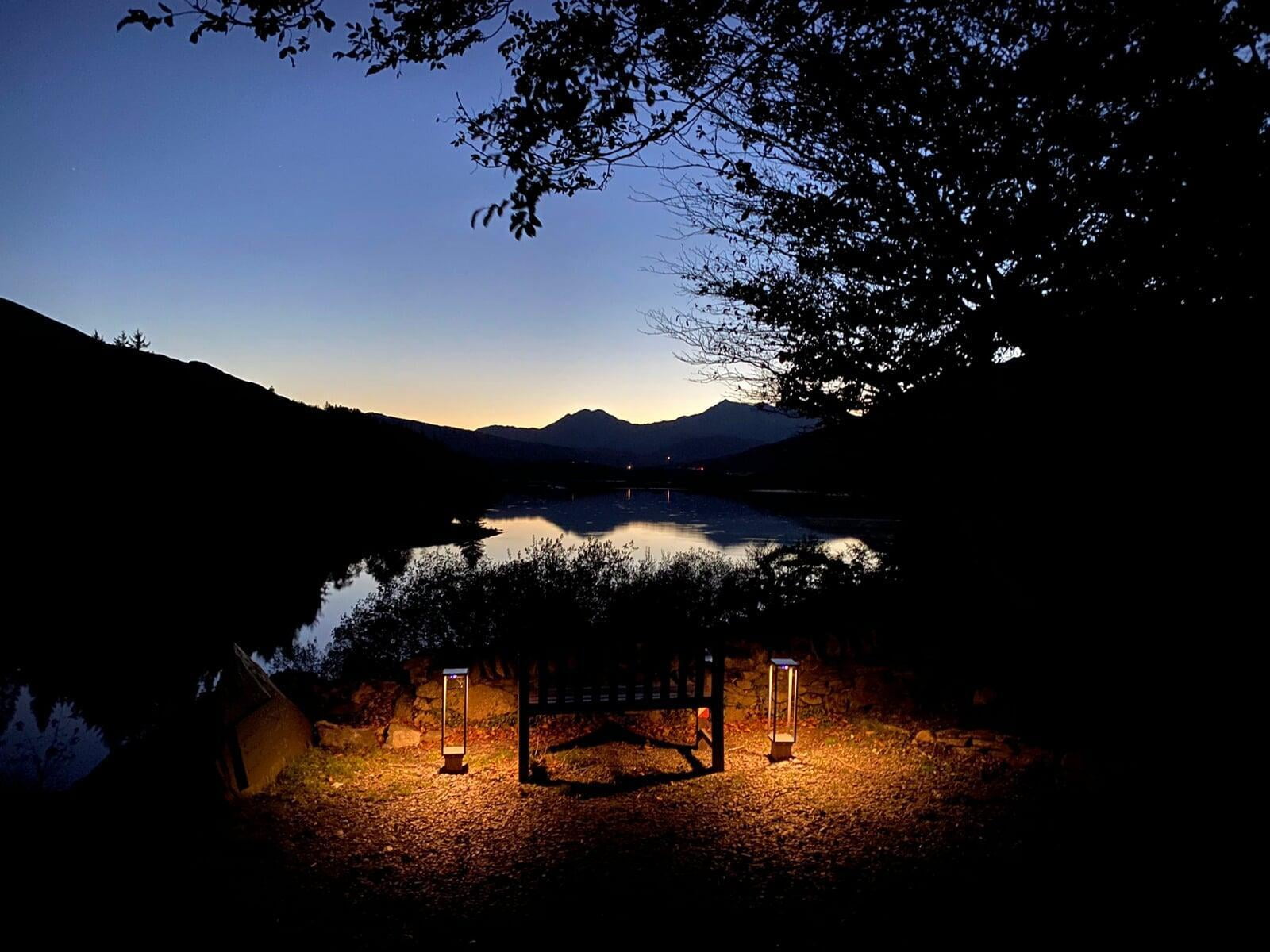
Plas Y Brenin Dark Sky Project
Dark Source
Plas Y Brenin is an ambitious transformation of an outdoor activity centre in Wales. Part of Snowdonia, the area attracts thousands of visitors annually, but has been suffering from light pollution and glare that’s visible for miles. Lighting design practice Dark Source, led by founder Kerem Asfuroglu, was brought in by the Snowdonia National Park Authority, in collaboration with Prosiect Nos, to enhance the night-time experience while cutting energy and the impact on wildlife.
Plas Y Brenin is an ambitious transformation of an outdoor activity centre in Wales. Part of Snowdonia, the area attracts thousands of visitors annually, but has been suffering from light pollution and glare that’s visible for miles. Lighting design practice Dark Source, led by founder Kerem Asfuroglu, was brought in by the Snowdonia National Park Authority, in collaboration with Prosiect Nos, to enhance the night-time experience while cutting energy and the impact on wildlife.
Existing lighting mostly consisted of fluorescent bulkheads and LED floodlights, which reduced the site’s legibility due to glare and uncontrolled light distribution.
Undoing light pollution is something that has to be done with a holistic vision, one which takes the site experience and character into consideration as well as refurbishing every existing light source.
The large majority of the lighting at Plas Y Brenin is achieved below the eye level and at door height, focusing the light on the horizontal plane whilst keeping it human scale.
All luminaires were made to face downwards to avoid upwards travelling light. All floodlights were removed. All entrance thresholds that are not a part of the main circulation used PIR sensors to avoid unnecessary illumination of non-essential areas. Existing bollard bodywork was refurbished and maintained. Only the light sources were replaced to reduce the material and economic waste.
The site now meets the dark sky quality required and delivers an engaging night-time experience.
Additionally, bats have returned to the site to forage around the hedgerows that over-illuminated before.
As a byproduct of the switch to LEDs, energy use was cut by 1.9 tonnes of CO2e (8000kW) annually.
Lighting suppliers include Heper, Stoane Lighting, Atrium, Flos, Mesh Lighting, Luce & Light, Thorlux and Osram
Photography: Dylan Parry Evans, Karl Midlane, Dani Robertson, Kerem Asfuroglu

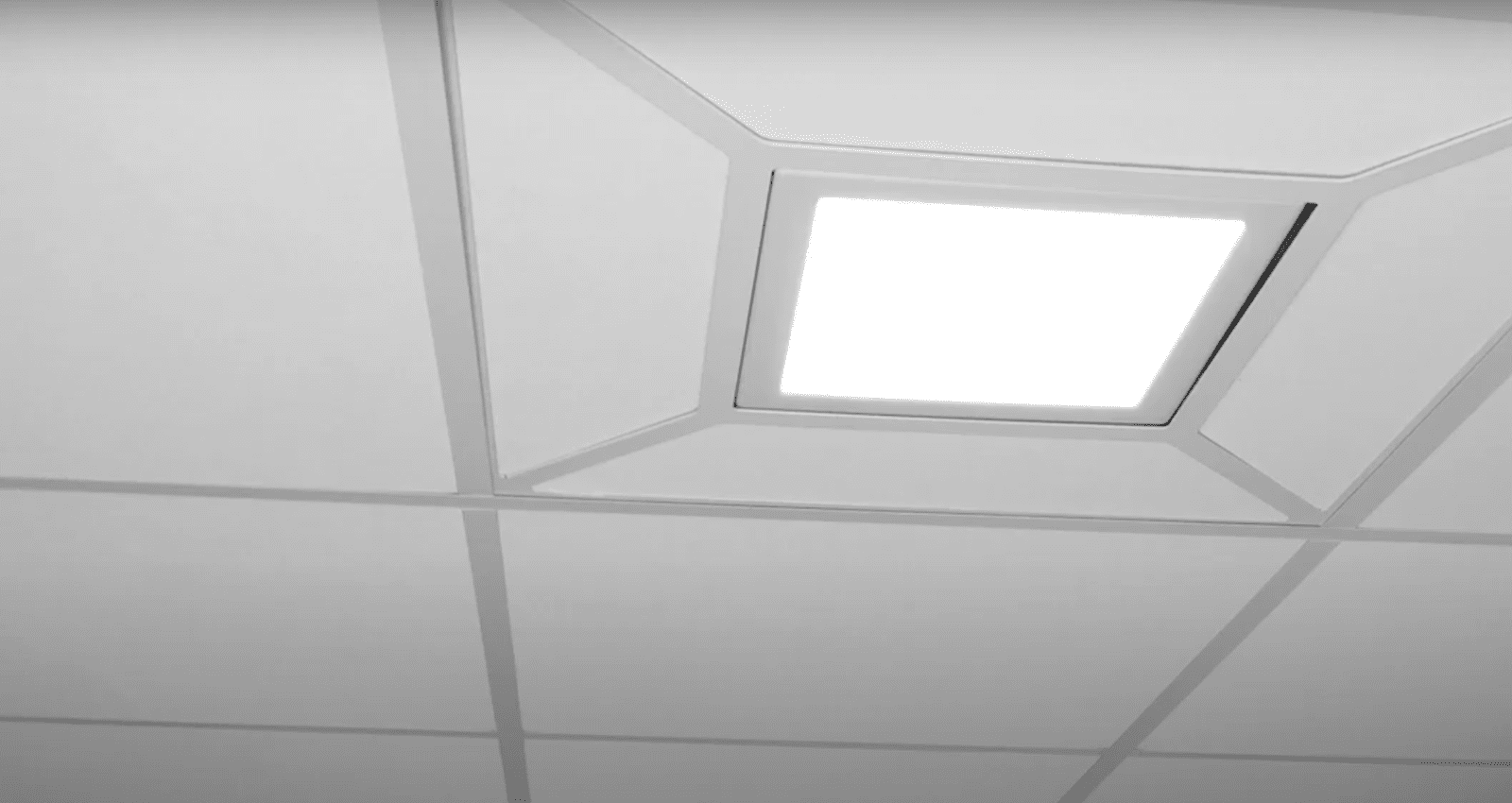
Lighting as a Service Brighteco
Lighting as a Service
Brighteco
Swedish company Brighteco makes panel luminaires from discarded computer screens sourced from waste and recycling centres. The fully serviceable light panels are sold on a subscription, lighting-as-a-service model and the company also takes responsibility for upgrading if necessary, as well as the reuse or recycling of the products at the end of their life.
The firm already has a number of installations under its belt, including a number of schools for which they pay a monthly fee.
Brighteco emphasises that it sells its product as a service - Lighting as a Service. This business model is used in order to secure and control a fully circular life cycle.
Its lighting fixtures are modular build with carefully selected components to ensure longest possible lifetime and the ability to be serviced and repaired.
The driver is rated for 50,000 hour life and projected lifetimes before first repair is 15 years. At the very end of product life every component, except the LEDs, can be retrofitted, reused or recycled thanks to a modular and circular design.
A recent study by Brändström and Eriksson shows that Brighteco circular lighting LED fixture reduces material need by 93% compared to equivalent LED linear lighting fixture.
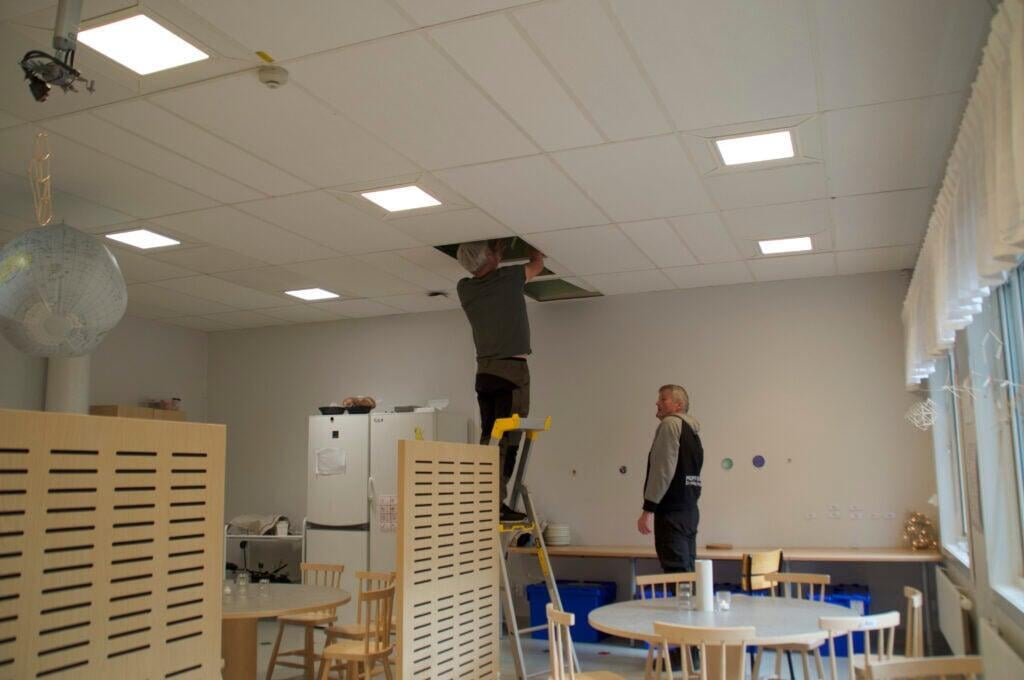

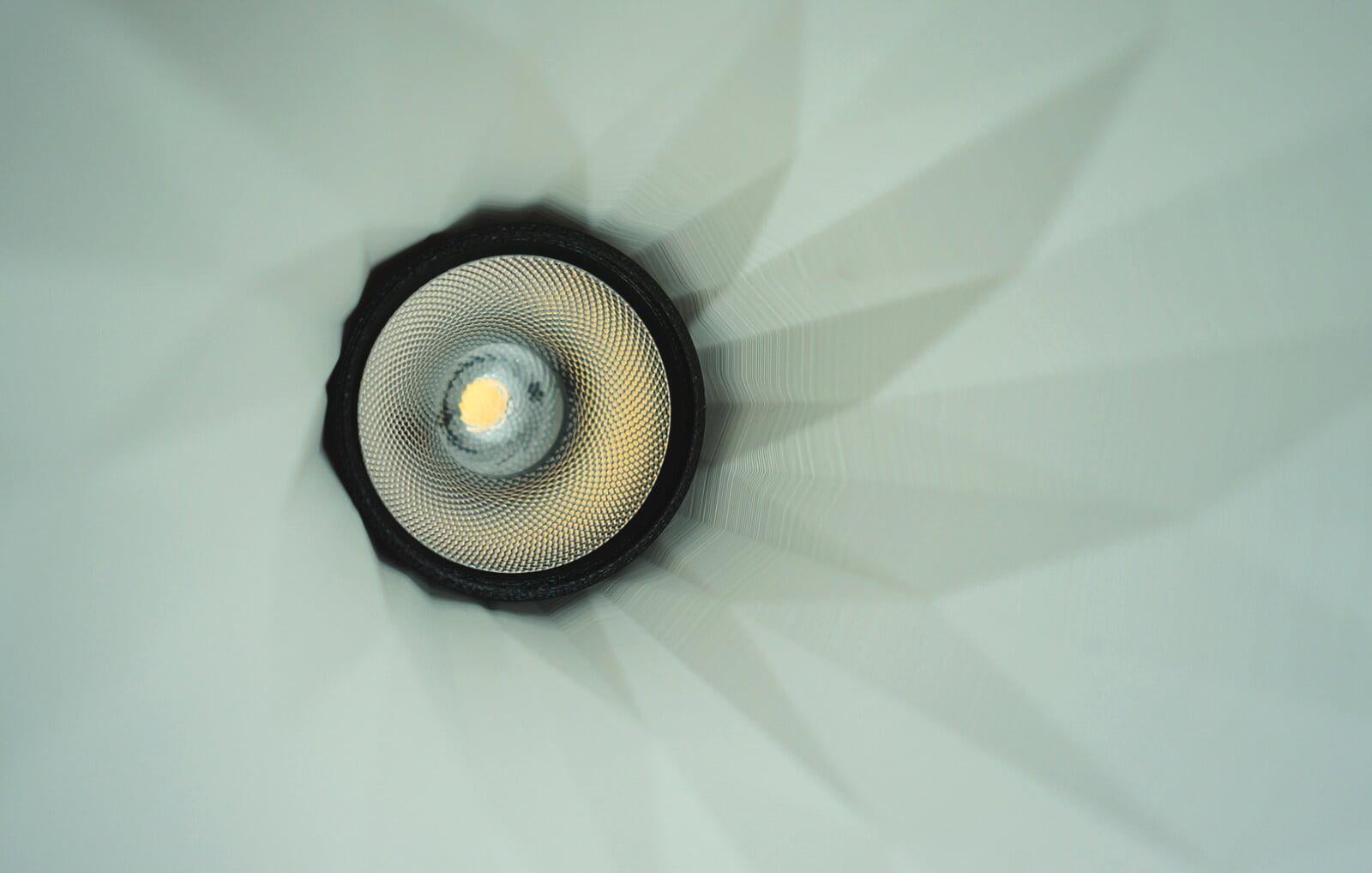
Sustainable Design FreedomLumiAdd
Sustainable Design Freedom
LumiAdd
A ‘complete rethink of the way luminaires are designed and manufactured’ is the force behind Sustainable Design Freedom from LumiAdd. The concept, created by two lighting industry friends, uses bio plastics to 3D print each luminaire to order.
Poly Lactic Acid is significantly more sustainable than conventional materials currently used in the lighting industry such as aluminium and petrochemical plastics.
It produces 97.5 per cent less Co2 emissions than aluminium from the Far East and 92.7 per cent less that from the EU. It can also be recycled or composted in industrial conditions.
3D printing to order results in zero waste and enables unconstrained design innovation. It also enables LumiAdd to manufacture and assemble in the UK helping to lower each product’s carbon footprint.
The luminaires are designed to be re-used, repaired and re-manufactured, with recycling or industrial composting being the last option.
LumiAdd even offers a buy back scheme to support the return its luminaires at the end of their first use.
LumiAdd products achieve the highest TM66 assessment category of excellent circularity.

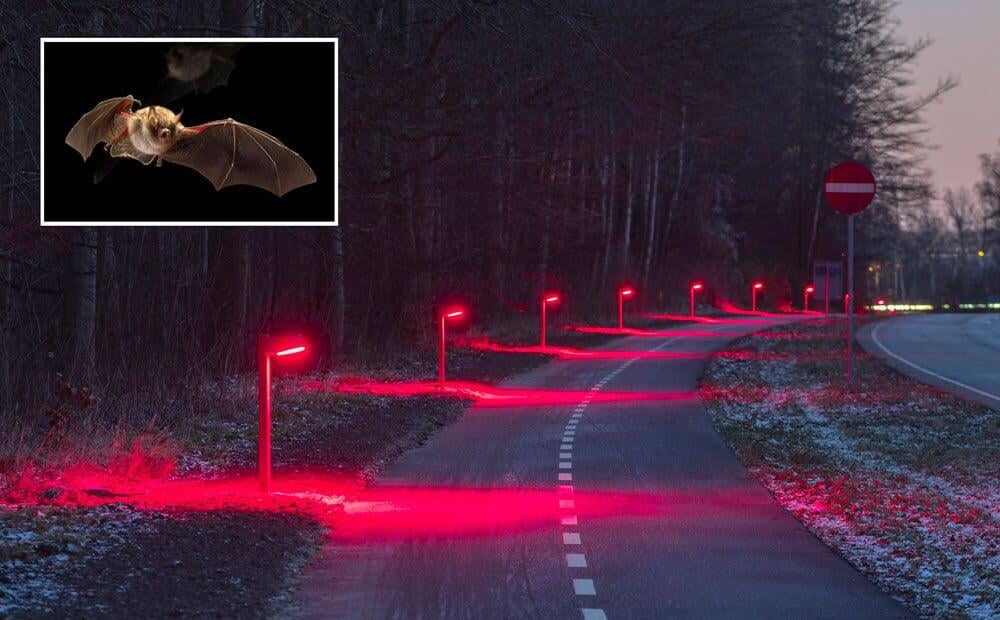
We Share The NightLight Bureau
We Share The Night
Light Bureau
The We Share The Night project is a bat ‘superhighway’ with specially tuned lighting. The streetlights along a stretch of road in Frederiksborgvej, Denmark, have been designed to have a minimal impact on the local foraging bat population while providing the required lux and uniformity levels for Danish road and cycle path standards.
The design practice, Light Bureau, used red light because research shows that it is less disruptive on wildlife while allowing people to find their way and even maintaining their dark adaption for nighttime viewing.
The project consists of of 30 bollards of 1 meter height spaced 30 metres apart to create corridors of complete darkness, allowing for light-shy species to cross.
Where cyclists and pedestrians cross the road, 12 higher poles of 3.5 meter have been placed, creating a change in the environment, helping to improve awareness and increase safety in these specific areas.
The lighting levels is 2.5 hemispherical lux and the uniformity 0.15 in the area where cyclists cross the street.
The Gladsaxe Kommune municipality created an awareness campaign in local media to inform local residents why the project used red light, which is radically different from what people would normally expect from street lighting.
The special luminaires were supplied by Danish lighting supplier Focus Lighting, a firm with a big commitment to sustainability, with modular design and its own repair and reconditioning workshop.
Designers on the project include Philip Jelvard, Rune Brandt Hermannsson, Henrik Sode and Allan Henry Tøxen Nielsen. Pic: Rune Brandt Hermannsson.

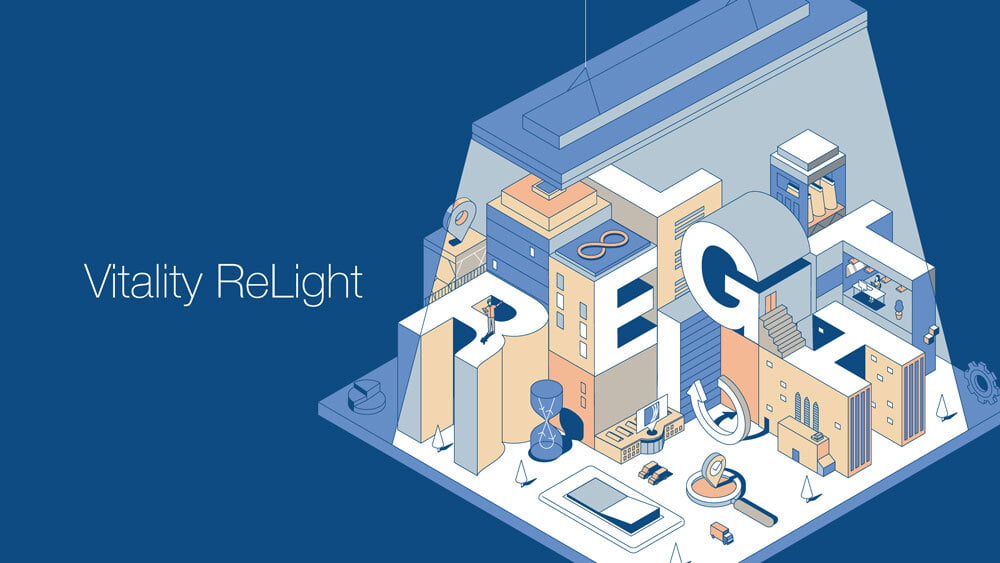
Vitality RelightWhitecroft Lighting
Vitality Relight
Whitecroft Lighting
The guiding principle behind Whitecroft’s Vitality ReLight is simple: During a lighting refurb, why throw away what you don’t need to? By retaining and reusing as much of the lighting components as possible, Whitecroft can cut down on the manufacture of new materials and reduce embodied carbon impacts.
It can also conserve the original embodied carbon associated with the building and reduce the amount of waste being created.
The company says it is challenging the traditional ‘take-make-waste’ economy.
The focus in a lighting upgrade should be to regenerate the space, deliver improved light quality, enhance performance and help to meet net zero goals in a circular way.
Whitecroft uses Cradle to Cradle Certified materials wherever possible.
In addition, it is the only UK lighting manufacturer with a luminaire regeneration process certified by British Standards Institute Kitemark.
It has incorporated circular design principles into its product design, focusing on design choices, modularity, innovation and transparency of data to enable choices for the product beyond simply recycling.

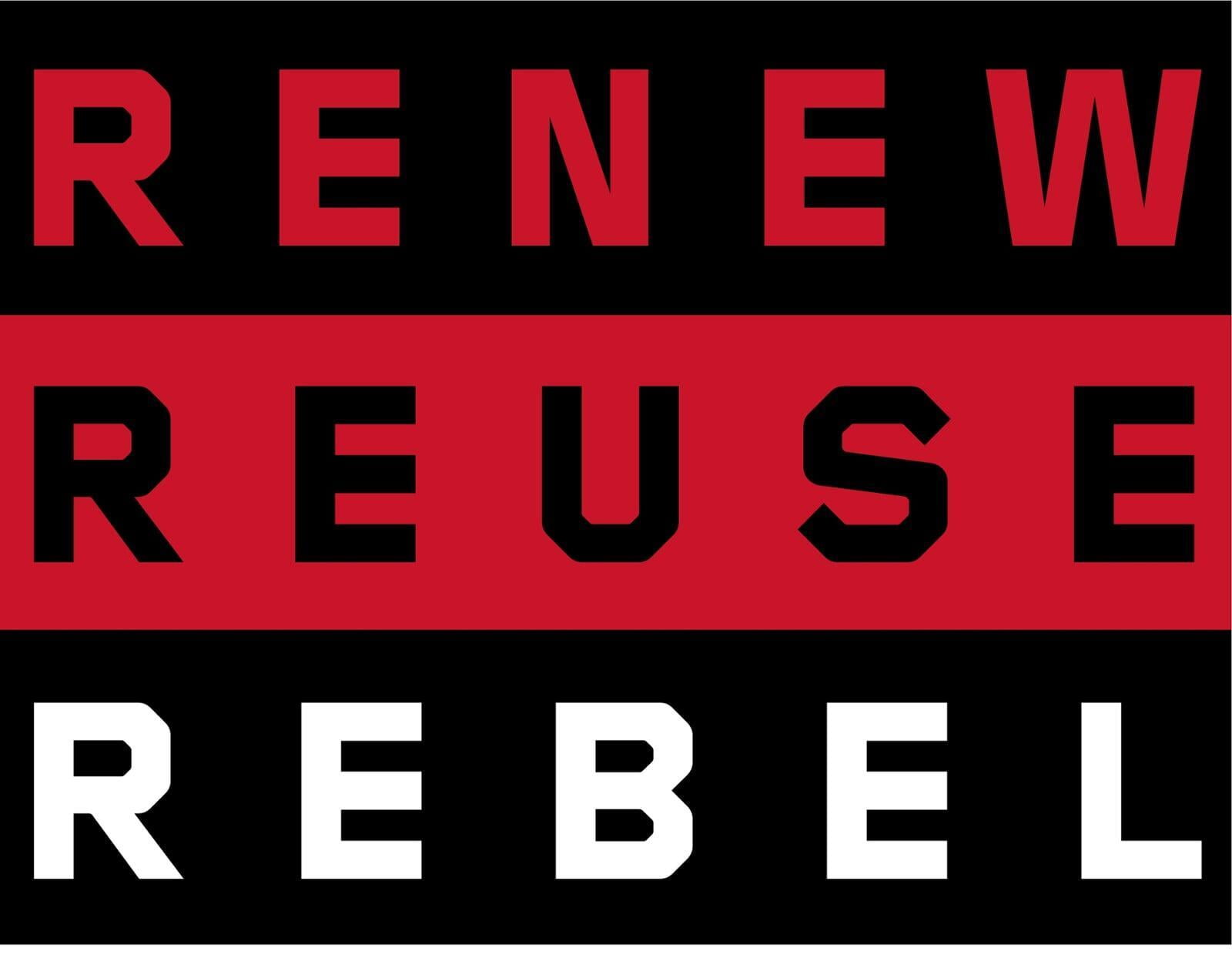
RENEW : REUSE : REBELRebel Light
RENEW : REUSE : REBEL
Rebel Light
RENEW : REUSE : REBEL is the name of a radical initiative from the distributor Rebel Light. The company says it redefines the role of a distributor by enabling renew and reuse services at large scale.
In January 2022 Rebel Light launched a circular business model to offer designers, clients and end users the opportunity to specify, purchase or rent state of the art technical lighting products and solutions according to circular terms and conditions.
The problem the firm noticed in the market for interior lighting was that the owner of a light fixture typically do not have use for the product over its whole technical life cycle. But how do you reuse something you don’t need?
By including a 20-year service for circularity with each product, Rebel Light is releasing the owner and the end user of the issue that piles of products would normally become.
And by including a service agreement for both design and technology with delivered projects Rebel Light can proactively work towards extending the lifetime of its lights.
It is changing the terms of purchasing and selling light fixtures, and establishing Rebel Light as a service and repair centre for architectural lighting.
Rebel Light says it is redefining the role of the lighting distributor by introducing a model for decentralised manufacture, renewal and maintenance of lighting products.
Rebel Light’s circular terms are simple:
• All products can be renewed 20 years from date of manufacture.
• Renewed products are sold with a warranty of five years.
• Rebel Light are authorised by the manufacturer of the product to perform all service and repair jobs. In many cases including on-site repairs via Rebel Light’s mobile workshop.
Rebel Light offer cash buy-backs on any product that was sold from the circular collection.
The business model is made possible thanks to a number of partners including Stoane Lighting, Orluna, Lucifer Lighting Company, Buck, formalighting, Control Department, Kucko and ZERO. Rebel Light’s goal is to sell circular products only by 2025.

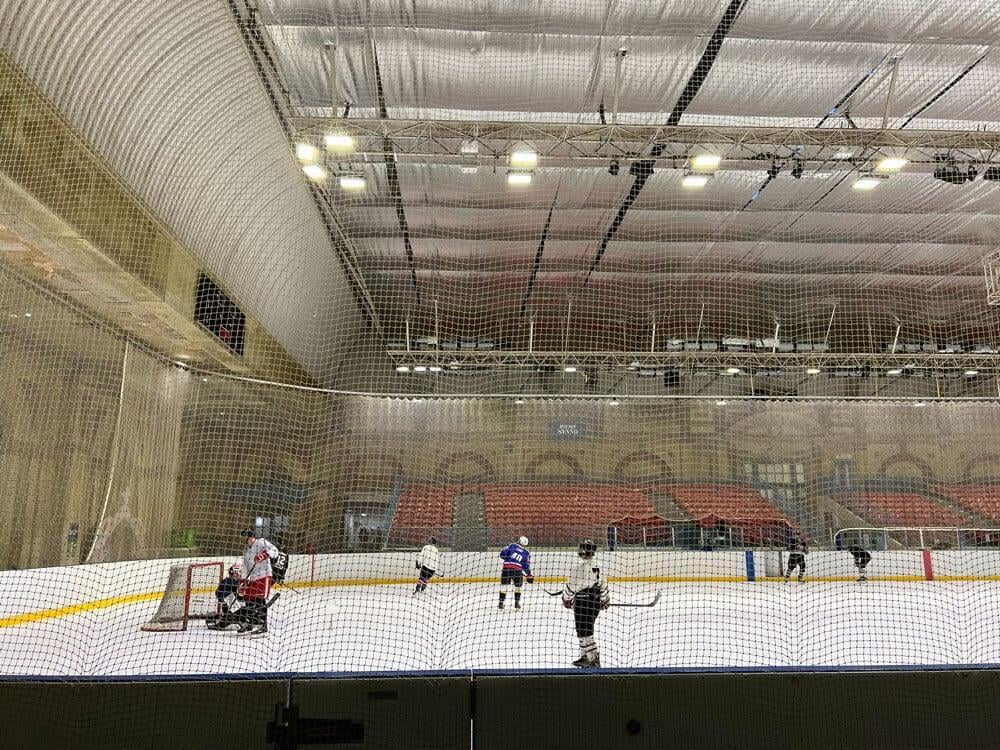
Alexandra Palace Ridge
Multidiscipline property and construction consultants Ridge worked with Alexandra Palace (‘The People’s Palace’) for the last six years on the development of a strategic and phased approach to the lighting improvements.
Multidiscipline property and construction consultants Ridge worked with Alexandra Palace (‘The People’s Palace’) for the last six years on the development of a strategic and phased approach to the lighting improvements.
The key goals and challenges included reducing the carbon use, reusing products and building fabric materials, reducing installation and commissioning time, reducing maintenance time between events and enhancing the user experience through new technology.
The decision on which new components to use was directed by how much of the existing components and fabric could be retained. Retaining the cove fabric and metal housing in the west hall dictated the dimensions, beam angle and aiming adjustment of the new product. It would arguably have been easier to take it down and put up a new cove lighting system but this would have generated excessive material waste which would have been difficult to recycle.
The project included illumination of the 100 feet high steel BBC transmitter mast, the East Court, the West Hall, the ice rink and replacement to ice rink café.
Circular economy and the reuse of lighting positions, materials and fixings was at the heart of the team’s design philosophy.
The process defined the position of luminaires and their format. The team reviewed methods of distribution, reuse of building fabric and the repurposing of equipment throughout the project.
The energy saved by the new installation was funded via Salix and met their payback criteria and was audited via a site visit from their project team. The West Hall alone saved close to 200 tonnes in Carbon emissions alone while providing the space with a performance specification controls system.
The total calculated savings in kWh for the entire scheme was in excess of 500kW/h per annum based on the West Hall and ice rink lighting and controls upgrades. At the time of calculation this was a saving of £75,000/annum.
Notable suppliers included Architainment Lighting, Dextra Lighting, Signify, Pharos and Dynalite.
Pics: Ridge / Lloyd Winters

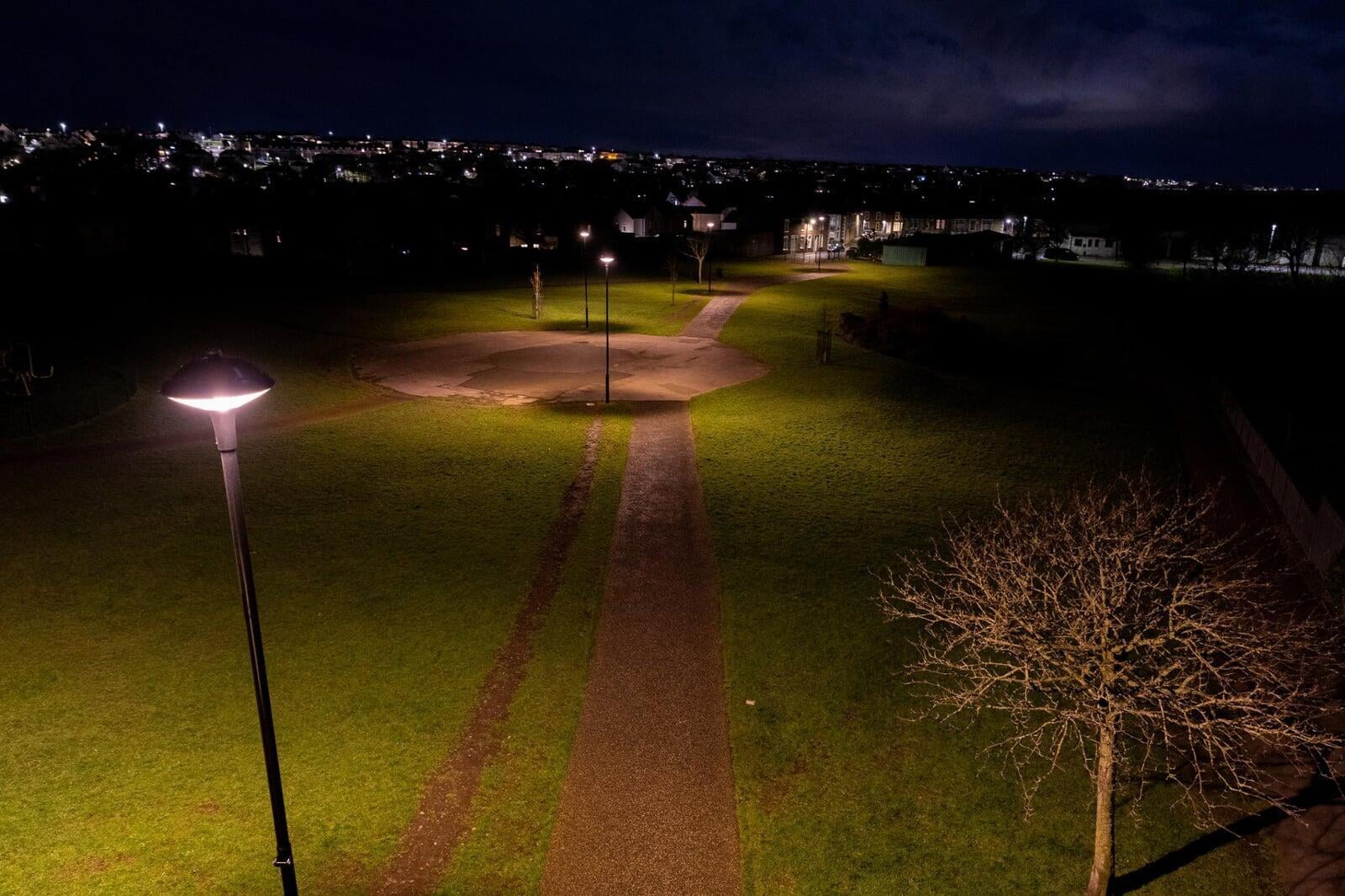
Cumbria dark sky lightingThorn Lighting and Cumbria County Council
Cumbria dark sky lighting
Thorn Lighting and Cumbria County Council
This is a sensitive dark-sky exterior lighting project in Cumbria in the north of England. Thorn Lighting worked with Cumbria County Council to create a lighting environment that protects dark skies, supports wildlife, improve perceptions of safety and encourages social interaction.
This is a sensitive dark-sky exterior lighting project in Cumbria in the north of England. Thorn Lighting worked with Cumbria County Council to create a lighting environment that protects dark skies, supports wildlife, improve perceptions of safety and encourages social interaction.
Many of the fittings feature the innovative NightTune technology, which reduces light levels and adjusts to a warmer colour temperature later in the night.
In the sensitive and historic Cliff Terrace in Kendal, Thorn’s EP 145 luminaire with a 2200K replaced the existing fitting.
This has eliminated spill light into gardens and homes and led to a reported return of nocturnal wildlife activity.
Community collaboration was paramount through the whole process. Residents were engaged throughout the process from inception to installation.
The EP 145 lantern was installed with a refurbished pole supplied by the Council. This luminaire also provides access to a replaceable LED module and driver, offering replacement opportunities for the future rather than wastage. All the products were supplied with ISO-accredited environmental Product Declaration (EPDs).

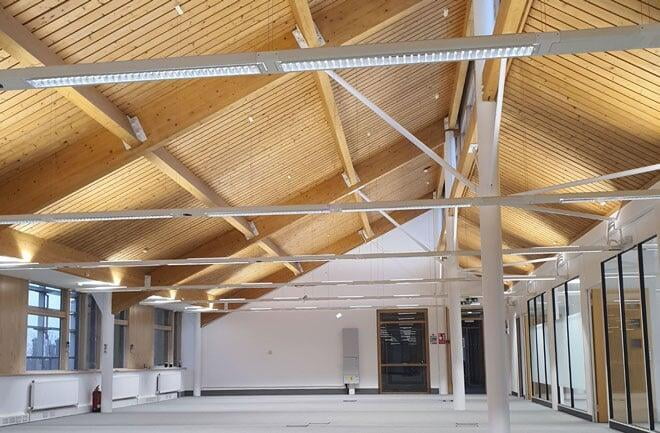
BRE refurbishmentSilent Design and Tridonic UK
BRE refurbishment
Silent Design and Tridonic UK
The Building Research Establishment has reused all its existing light fittings in a major upgrade of the lighting at its headquarters in Watford, UK. The fluorescent-to-LED refurbishment project saved 252 kilograms of luminaires’ bodies from removal and resulted in energy savings of up to 45 per cent and increases of light output to up to 35 per cent.
The Building Research Establishment has reused all its existing light fittings in a major upgrade of the lighting at its headquarters in Watford, UK. The fluorescent-to-LED refurbishment project saved 252 kilograms of luminaires’ bodies from removal and resulted in energy savings of up to 45 per cent and increases of light output to up to 35 per cent.
Lighting firm Silent Design refurbished 180 28W T5 fluorescent continuous linear suspended linear lights, 52 twin 18W PL fluorescent downlights, 16 40W T5 round fluorescent bulkheads and nine twin 40W PL 600 x 600 recessed modulars.
The lighting was originally controlled by a Philips Helios system with integrated PIRs. Silent replaced this with a DALI lighting control system run on a wireless Casambi platform.
Most lights were up and downlight which presents a challenge for LED as they required LED boards pointing up and down. This required a new heatsinking aluminium plate to be made up to facilitate this.
Additionally, the LED boards needed to be enclosed to prevent being touched as they were running at 75V DC.
Silent Design used a Tridonic ACL lens cover to provide this level of protection and allow ease of maintenance in the future as these simply clip onto the LED board screws.
The fitting were then tested photometrically after being retrofitted with the LEDs. This was carried out by LUX TSI in Wales so that the suppliers could prove output and provide lighting calculations.
For emergency lighting, Silent decided to integrate a dedicated EM spot to give 110 degree coverage compared to the 65 degree that the louvre would have given.
This allowed the company to use about half the required emergency lighting and associated battery packs which in turn reduced the environmental impact of the retrofit considerably.
The wide emergency spotlight delivered 450 lumens. LiFEPO4 lithium ion batteries were used for long service life
The original track used 18W PL lamps. These were replaced with 10 watt Cree LED chip and a custom heatsink. Again, Casambi wireless controls were used with integrated PIRs.
For the linear lighting, the LED boards run at 350mA current and deliver 3,700 lumens of light output with a power consumption of 21W. This is a 900 lumen increase in output and a 30 per cent reduction in energy consumption. With 180 lights, that’s a 1.260 kWh saving every hour of running.
Additionally, the LED Boards are rated at a 60,000 hours lifetime against 30,000 hours for the fluorescent tubes they replace.
For the track lights the energy savings is 45 per cent less consumption for the 10W LED lamp and a 35 per cent increase in light output versus the PL lamp it replaces.
Some 92Kg of waste was removed from the site. This comprised lamps, ballasts and internal wiring. Some 252Kg of waste in the form of the existing lighting bodies was prevented from removal by their reuse.
Finally, 216 metres of plastic diffuser saved by not using new lighting.

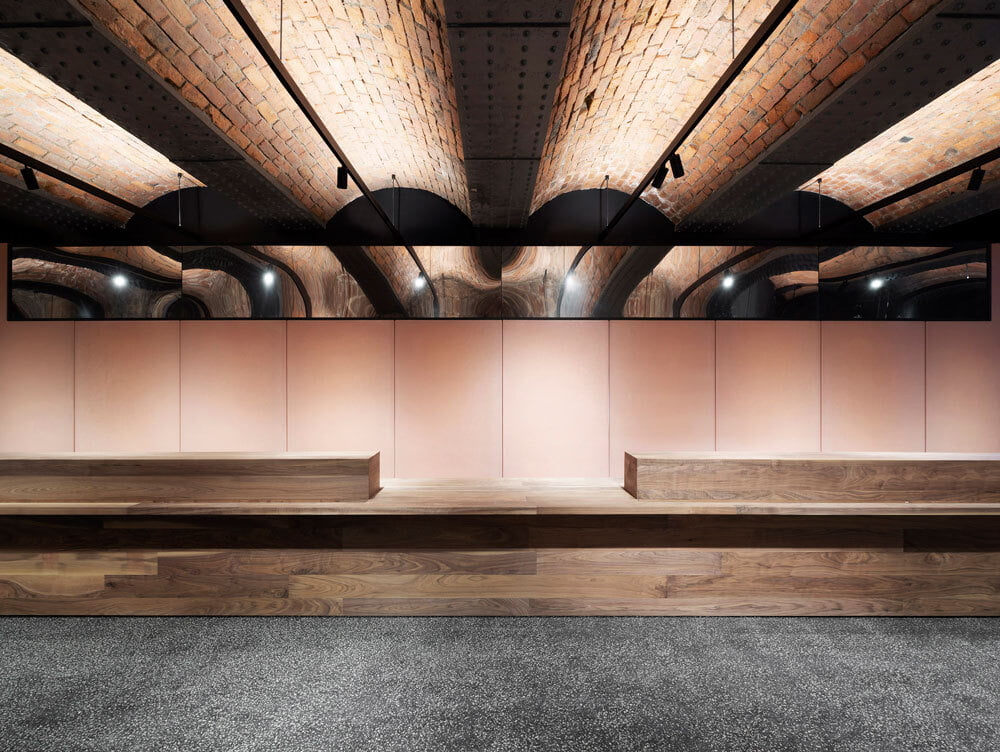
Special Exhibitions Entrance, Museum of Science and Industry, ManchesterPJC Light Studio
Special Exhibitions Entrance, Museum of Science and Industry, Manchester
PJC Light Studio
Lighting has played a key part in transforming a dark and unwelcoming space under a railway viaduct into a vibrant new entrance to Manchester’s acclaimed Museum of Science and Industry. The museum is housed in some of the world’s most important surviving buildings and structures from the Industrial Revolution.
Carmody Groarke Architects wanted to create stronger orientation and access between buildings, and the lighting by PJC Light Studio was crucial.
The clever use of full-height fibre-glass panelled walls alleviates the oppressive atmosphere of the heavy Victorian structure overhead. The panels are subtly back-lit, revealing the maker’s mark in their surface whilst gently illuminating the spatial and decorative qualities of the historic cast-iron and brick jack-arch structures.
Linear uplight concealed within the suspended track brings emphasis to the vaulted ceilings to help reinforce the interesting geometry of each space.
An intentionally minimum number of discreet track lights are used to provide accent lighting to the reception furniture and key surfaces, introducing another layer of interest.
A load density of less than 10W/m² has been achieved delivering varying lux levels with an average of 200lx at floor and higher accent levels at the reception desk.
The majority of lighting is supplied by Reggiani and Mono Lighting controlled through a Philips Dynalite system.
Pic: Gilbert McCarragher

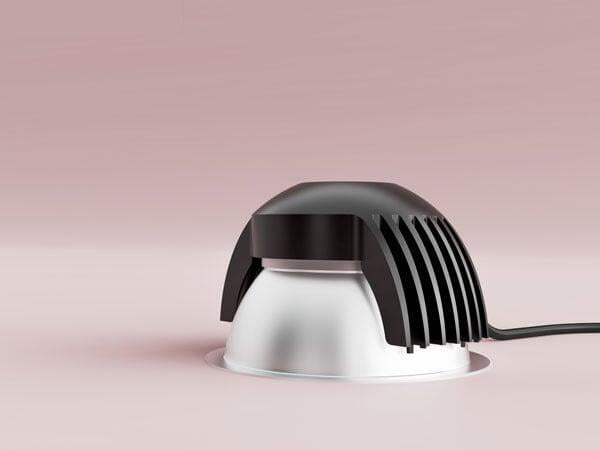
A Strange Form (Xenomorph) Matt Black
A Strange Form (Xenomorph)
Matt Black
A Strange Form (Xenomorph) from design house Matt Black is a concept to create the most circular downlight possible. The idea originated in a search for singularity, says Murray Ward, founder of Matt Black. 'What would happen if the design process focused primarily on the industry’s most popular luminaire in terms of the largest number of units shipped?', the product designer asked.
The industry's most standard unit is a circular downlight with a ceiling cut out of 120mm and ceiling thickness of 12.5mm.
As the product is intended to be designed around circular principles, the bespoke components are all recyclable and can be manufactured from recycled materials. The product can be dismantled with just one tool.
To help maintain the luminaire, it is essential that the main components are easily accessible. This is supported by an absence of springs and mechanical fixings, magnets which create a stress free installation and de-mounting process, damage-free removal from the ceiling on de-mounting, a quick installation guide pad printed on the heatsink.
Using the Optoga IoT LED module means that it is as easy to exchange the control unit (Casambi/DALI) and the light distribution by exchanging the lens. There is no external driver as all components housed within the luminaire.
The addition of a QR code gives the person disposing of the product the information they require to have the product reused, recycled or remanufactured.
There is a small component count, an efficient assembly process and the components are easy to procure with minimal secondary processing. Each component has been designed with transportation in mind and are therefore stackable and space saving. Where possible, the components are procured in the same country as where the luminaire is manufactured.
The product is adaptable and with modular accessories can be installed in both 25mm and 1mm ceilings. There is also a plaster-up version. By adding a clear or frosted disk to the reflector, the product becomes IP44.
For the customer, A Strange form (Xenomorph) delivers light quality, green credentials, efficient installation, value, no light leakage, adaptability and design freedom.

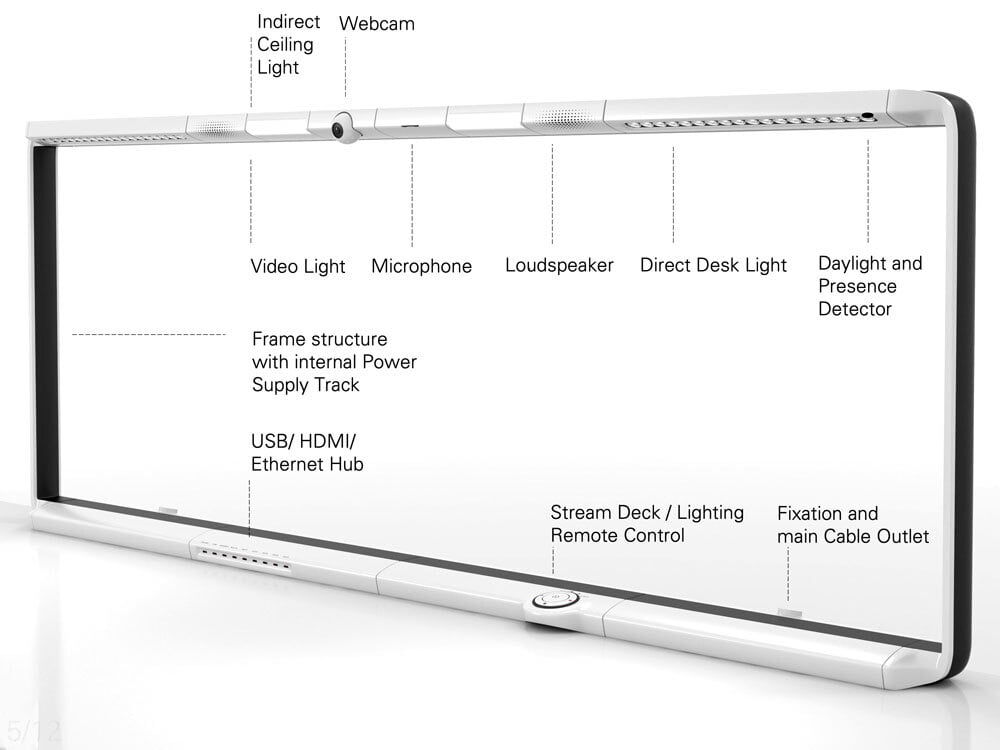
OP1 Office Portp14x Innovations
OP1 Office Port
p14x Innovations
The Office Port is an innovation to tackle desktop clutter and integrates illumination, video, acoustic, sensory, power distribution and communication devices. Backbone is a power, data and mechanical fixation track which adopts various technical devices such as direct and indirect lighting components for room lighting, video lights, cameras, light controllers, microphones, USB connectors, computer screen holders, stereo loudspeakers, separation walls, acoustic noise reduction panels, white walls, plant holders and many more.
Individual characteristics of the architectural and interior design can be adopted through variations in shape, colour and material.
This ranges from residential home office environments with warm colours and natural materials to a high tech black-and-steel work model.
Modules and covers are fixed by a snap-in mechanism, common standard interfaces, such as USB-C, DALI-4i, one- to three- phase power tracks (high or low voltage) or established electric contact systems.
Built as a flexible system it works as a stand-alone solution for single and multiple desk units as well as for conference solutions or reception desks. As it comes with direct and indirect lighting components it could make additional fixed ceiling lights obsolete.
The modular structure allows flexibility in space changes, increases usable desk space, creates an aesthetic order and reduces maintenance.
It minimises material use and installation effort through multi use of power transformers and the reduction of device housings.
It allows easier upgradability and repairability through interoperable components with standardised interfaces.
PRODUCTS

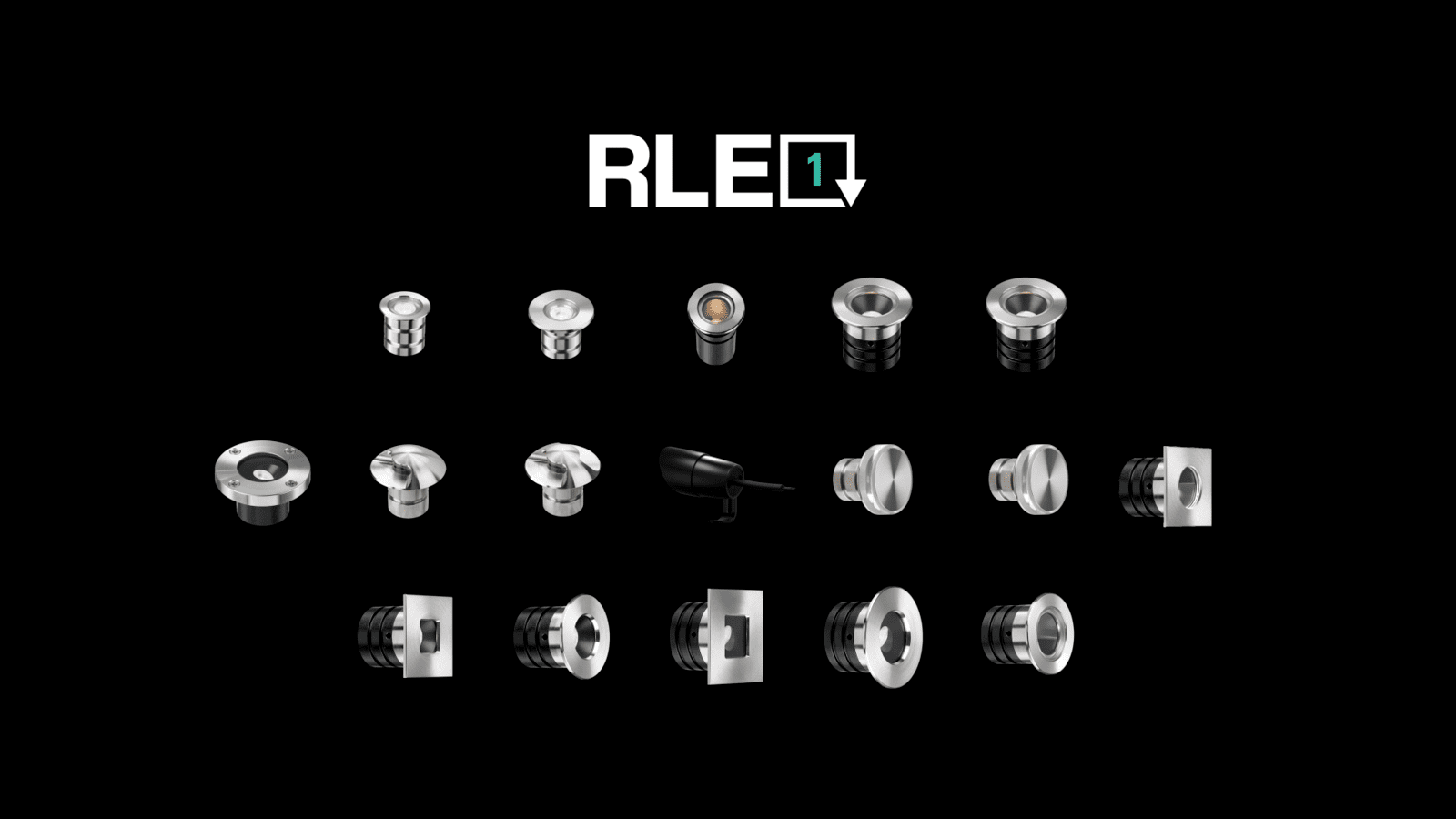
Replaceable Light EngineLightGraphix
Replaceable Light Engine
LightGraphix
The Replaceable Light Engine from LightGraphix gives customers an unlimited ability to repair and upgrade LED fittings at any stage in their lifecycle, renewing them for decades, with minimal material waste as a result.
All the systems are based on a single modular engine insert consisting of the LED and optic, which reduces project lead times on RLE products and offers easy disassembly at the end of life for recycling.
It also means physical repairs and upgrades can be conducted onsite, removing the need to return the fitting to the factory to await repair and halving the shipping emissions.
The main challenge during development, says the company, was ensuring that high IP ratings and anti-wicking cable water ingress barriers were maintained, as its products are often used in harsh marine settings.

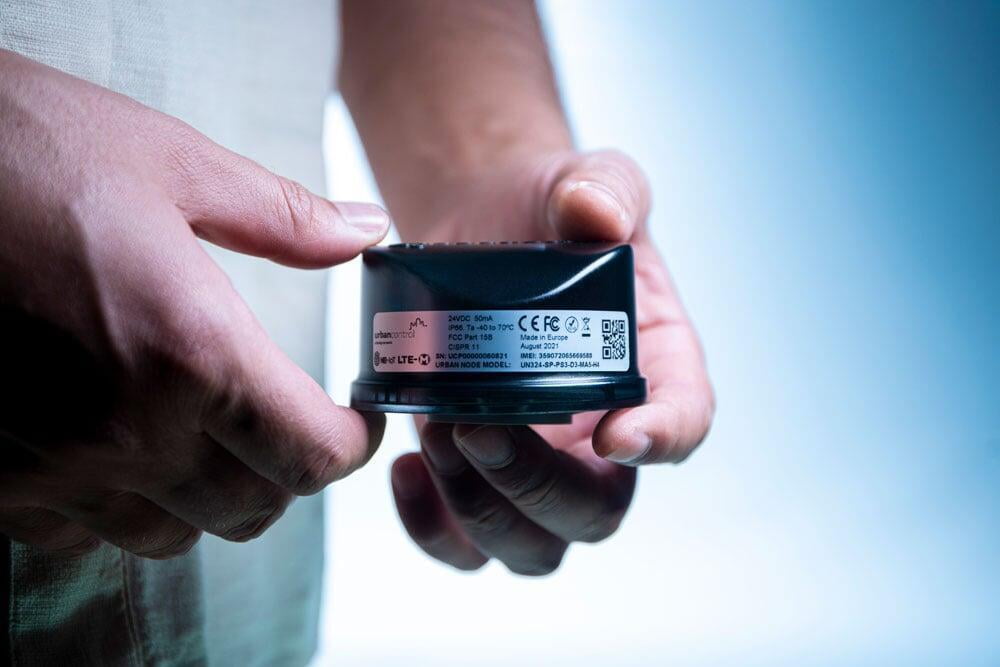
Cellular NodeUrban Control
Cellular Node
Urban Control
Urban Control’s Cellular Node is an innovative plug-and-play IoT LED streetlight controller designed to lower energy use and cut carbon emissions while improving safety.
Featuring a standardised Zhaga socket, the Node connects to lighting infrastructure allowing highway agencies and local authorities immediate control of their street lighting networks.
But unlike traditional wireless lighting control systems that require a specialised network to be built, the Cellular Node accommodates NB-IoT and LTE-M standards and connects over existing 4G and 5G cellular networks, just like a mobile phone.
In addition, the Node works straight out of the box without the need for separate gateways, making it a cost-effective solution for deploying lighting networks anywhere and at any scale.
It allows precise control of lighting outputs through remote ‘dimming and trimming’ techniques. In addition, the Node can automatically provide reporting on faults, further saving monitoring and maintenance costs.
When paired with additional sensors, the Cellular Node can provide dynamic lighting, which automatically adjusts depending on footfall or road traffic. This ensures adequate light levels during peak periods, offering a sense of security while minimising wastage during quieter periods.
In addition, by utilising dynamic controls, it is possible to minimise the impact on nocturnal wildlife by switching off or dimming street lights when nobody is present. Urban Control is part of DW Windsor.

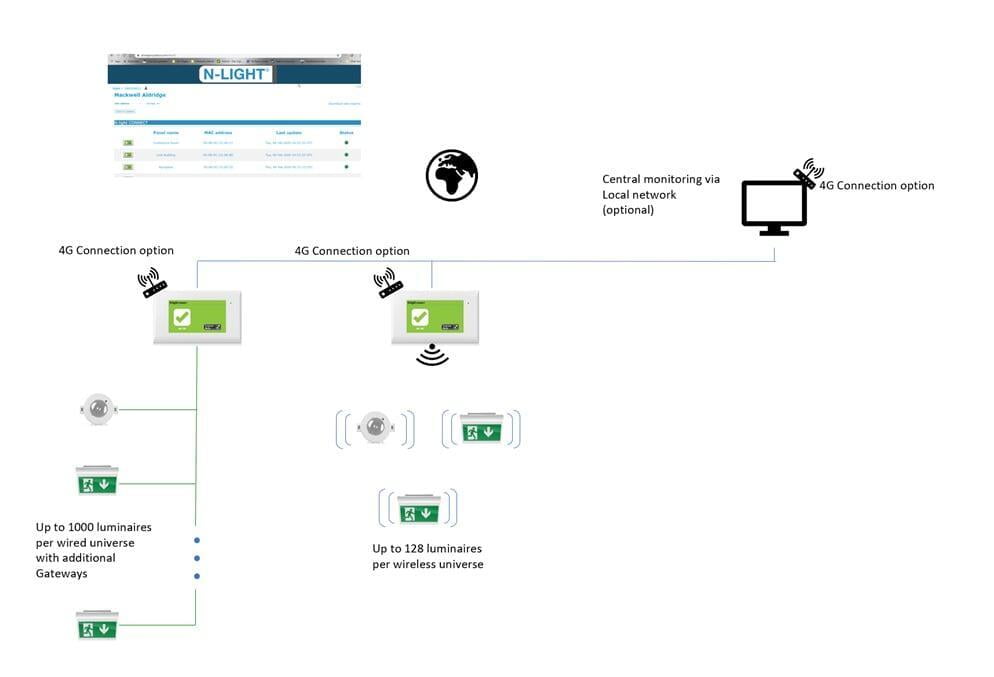
N-Light CONNECT+ Mackwell
N-Light CONNECT+
Mackwell
Emergency lighting must undergo monthly function and yearly duration testing. Traditionally, this was carried out manually by turning a key switch on a wall, observing the result, and maintaining the logbook. Yet this is highly time-consuming for those managing emergency lighting over multiple sites and estates.
Automatic testing systems within new buildings have become common practice, yet in existing properties this is not the case, and many are still run by a single facilities management team. Mackwell therefore created a smart, automated solution to streamline the process and use technology to assist in these challenges.
The N-Light CONNECT+ DALI emergency lighting test and monitoring system removes complexity and focuses on safety. It provides an advantage that was not available before: being able to view the status of emergency installations at any time, from anywhere - all on one single interface, by modifying these existing buildings with innovative new technologies.
The system is a complete, scalable, and integrated monitoring solution that allows wired and wireless monitoring as well as cloud connectivity all in one system. It includes DALI controls and intuitive interfaces and is compatible with all Mackwell DALI emergency components.
A single touch panel can control up to 1024 devices, creating simple fault reports for quick rectification. Monitoring and maintenance can be achieved through the Mackwell Configurator software which creates an automated tree format to view and issue commands to 1000 devices.
Through cloud monitoring, all test reports and current system status are online and are accessible for the responsible person with dedicate and personalised logins.
It has multi-site support, ideal for monitoring larger buildings, retrofitting to existing buildings or for use across multiple sites and complete estates.
The benefits of this system are that it removes the need for continuous site safety checks, saving a significant amount of time, improves the accuracy of detecting faults by offering real-time system updates and it allows management teams to know exactly which part of a building and site needs attention.

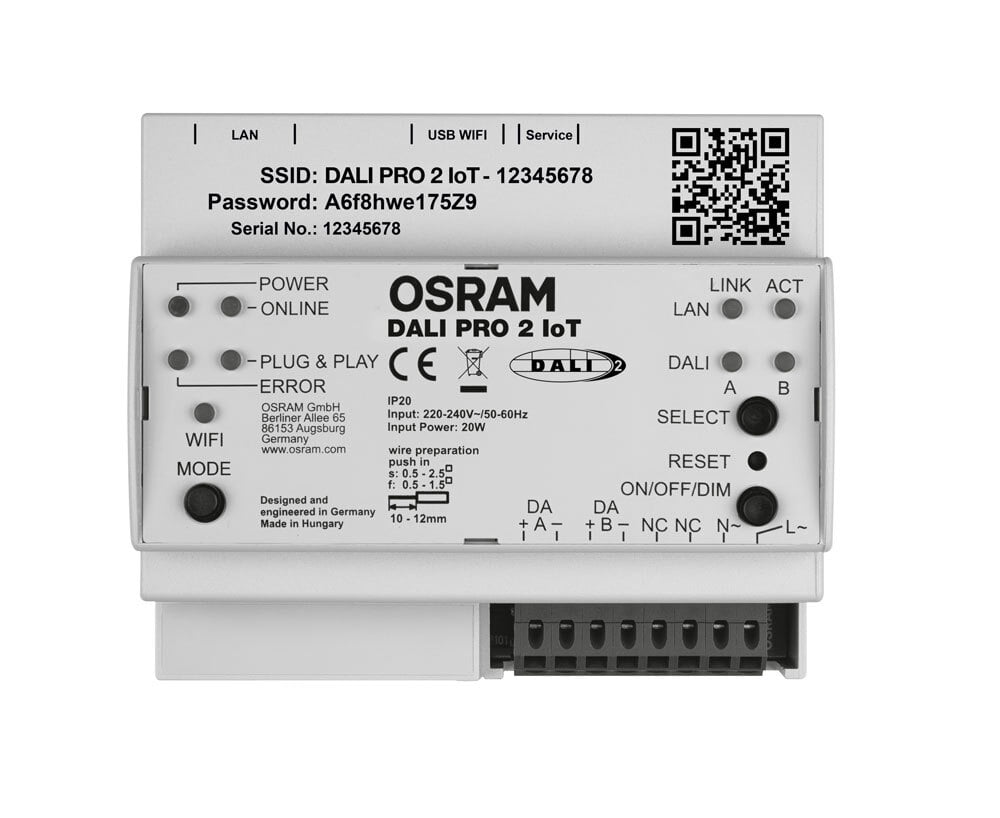
DALI PRO 2 IoTOsram
DALI PRO 2 IoT
Osram
Osram’s DALI PRO 2 IoT is the first DALI2 certified controller with integrated IoT gateway and open rest API to enable IoT use cases.
The innovation provides a simple way to access cloud applications.
Once installed, commissioning is achieved via an intuitive user interface, using either a notebook computer (LAN or Wi-Fi) or a smart device (Wi-Fi).
The built-in gateway offers access to automatic firmware updates and enables IoT applications which can include remote access, emergency lighting and open REST API, which allows for integration to third party software and cloud apps.
For instance, facility managers can use the platform to monitor
their lighting installations, get insight into individual energy consumption areas, provide information for potential optimisation of the lighting system configuration and identify maintenance needs remotely.







